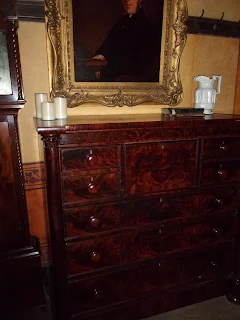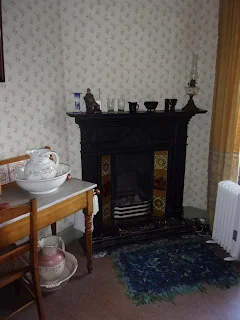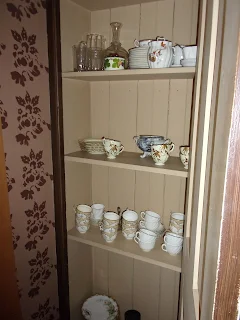It was an uphill schlep north, past a scaffold-covered Glasgow School of Art, to get to the Tenement House in Buccleuch Street, which is operated by the National Trust for Scotland. And what a handsome building it is!
In England the word "tenement" tends to be synonymous with slum housing, whereas in Scotland from the mid-19th century (although there were slum tenements) it simply refers to a stone building with two or more storeys, with one or more apartments on each level and a common entrance and stairs.
The building dates from 1892 and the flat in question is a first floor time capsule, occupied by Agnes Toward from 1911-1965. The ground floor flats have now been bought by the National Trust and act as the reception and exhibition area.
Here's an authentic fireplace in the museum room.
Miss Toward amassed artefacts from all aspects of her life, so we are able to get a very good view of what she was about. These are objects from Miss Toward's sewing box. She lived alone with her dressmaker mother, as her father died when she was three and her two sisters had passed in infancy.
A homemade tea cosy, and Agnes was born in 1886. From 1914 she worked as a shorthand typist (the same profession as my mother.)
We know that she was petite (less than 5' in height), that she played with a doll called Rosa and had a cat named Tibs.
Agnes Toward, and she appeared to have kept everything from recipes, letters, bills, postcards and theatre programmes (she enjoyed musical shows), so it's possible to build up an idea of her likes and dislikes.


The next room shows a model of a tenement building. This is an ordinary red sandstone building, although early tenements were built in local white or honey-coloured sandstone.

Another classic fireplace (the house I was brought up in, which dated from 1905, also had beautiful fireplaces like this, restored and painted by my rather artistic father).
Could this be Rosa sitting at the back?
The cleaning of the stairs was a shared responsibility, and you can see the tiles coming down the side of the stairs. These were common in wealthier tenements. This tenement building contains flats which are still lived in today.


This room contains a selection of letters received by Agnes from her friends in London. She trained as a secretary in 1905, at a commercial college in Buchanan Street, which is in the city centre.
More household everyday essentials and the kind of decorative tiles that would have been found in tenements such as this.
A letter to Miss Toward, and isn't the handwriting elegant? I hope that, in this day and age of computers and texting, that it's not a skill that gets lost.
The flat consists of four rooms opening off this central hallway. Most of the furniture belonged to Agnes- much of it inherited.
Incidentally she had electricity installed in 1960 but made no major changes to the property. For authenticity purposes the original gas lighting has been restored.
Another lovely fireplace, although bedroom fires were only lit when someone was ill. You can make out the marble-topped washstand, although I suspect that the radiator is a modern addition!
Agnes' bed, and she lived here alone after her mother's death in 1939. She never married.
Agnes' traditional wardrobe, and brass beds like these are still popular nowadays.
Agnes' dressing table is very feminine, with its perfume bottles and vanity set. My mother owned similar items as did I in the house I was brought up in, which was traditional rather than modern.
This sewing machine in the corner looks like some kind of embroidery machine (I should know- I did study fashion, after all. But my time in that industry has long since passed...)
Agnes' parlour, and apparently rooms such as these were only used on special occasions. The china bell to the left of the fireplace was used for summoning the maid, but it's unlikely that the Towards ever employed a maid here.
The table is set for afternoon tea. How genteel!
During those days people tended to spend more time in the kitchen- it would be the warmest room in the house, after all.
The piano, and we know that Agnes liked to listen to the wireless. Set-in beds like this were only found in tenements built before 1900.
They provide extra sleeping space, but ended up being banned for health reasons.
The china cupboard in the far corner...
Into the kitchen, and this is a typical black range.
The table in the centre of the room, and ironing would have been done on this table.
Small items of washing could have been washed here, and wrung out using the wringer (my nan had a larger version of one of these- I vaguely remember my mum using it outside in my nan's yard, but memories are shady as we're going back about 50 years...) Larger items would have been washed in the now-demolished communal washhouse, and there was a strict rota for its usage.
Hot water which was heated by the range once sat in a tank situated in this cupboard, where it could be piped to the sink and bathroom.
In this cupboard are jams made by Agnes but never eaten. The oldest is marked "Plum 1929." I would love to taste it to see what it's like, and whether it has stood the test of time!
Cooking implements, and some- like the lemon squeezer- are relevant today. A quart can, which milk was delivered in, can be seen hanging up. The coal bunker sits underneath this area, delivered by a merchant who carried the sack up the stairs on his back.
The set-in bed with an old fashioned stoneware hot water bottle. A lot of things I saw here are very familiar, as I was brought up in a big, old house with many pieces of furniture and household items inherited from my nan.
The bell for calling the maid, and household help was cheap at the time. Many families in Buccleuch Street had a maidservant.
A mouse (or is that a rat? It looks rather large!) and his trap in the corner...
The bathroom, and I can still remember there being outside toilets with high cisterns like this at my infant school. Thankfully they were torn down- I was always worried that the contraption was going to fall onto my head!
The Towards were lucky, as many tenements shared an outside privy with their neighbours, although some tenements had communal toilets inside; one on each landing.
A collection of cosmetic jars and medicine and perfume bottles adorn the windowsill...
A closer view, and I can also remember that awful Izal toilet paper! I'm sure it remained in school toilets up until the 1980s.
View down into the deep bath tub, and families who didn't have a bathroom would have used a tin bath.
The gas meter, and you can just about make out the wicker laundry basket, which would have been used for hanging out and collecting the washing in good weather.
A Vain Old Tart photograph, and the Towards rented their flat. Glasgow tenements were often managed by factors. These were the owners' agents, and their chief task was to collect rent.
The "marble" sink is actually porcelain, to create a good impression for visitors.
I loved the sink and would be happy to own one like this myself!
This downstairs part never belonged to the Towards, but it's used for educational purposes and possibly an extension to the tearoom.
Agnes Toward left the building when she went into hospital in 1965, dying ten years later. She had no-one to leave her belongings to but, having been involved in church life, left a set of chairs to a church elder, who thankfully brought his niece with him when he went to collect them...
That was very fortuitous for this shrine to history as his niece- a Scottish actress called Anna Davidson- bought the flat for herself. Realising what an important part of social history she had on her hands, she sold it on, in 1982, to the National Trust for Scotland.
This is the tearoom, but we didn't linger for a cuppa.
There is also a little shop with this display in it.
It's believed that Agnes' mother wore this black dress on her wedding day, in April 1884. Black seems a somewhat unusual choice nowadays!
I'm so glad I visited this building as it's a wonderfully personal snippet of Glaswegian history. Nowadays community housing associations have bought many tenement buildings and improved them, bringing them up to modern standards and cleaning the grimy stone exteriors so that they once again sparkle like new. This style of property is still sought after today.
It was an incredibly enjoyable and educational (and I'm devoted to lifelong learning) kind of day.
TTFN
Miss Elaineous
XXXXXXXXXXXXXXXXXXXXXX
XXXXXXX
XXX
XXX








































No comments:
Post a Comment